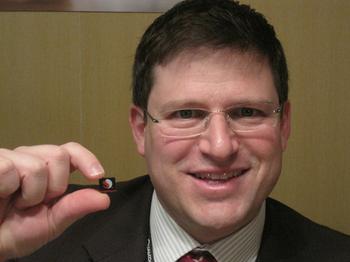Enter the dragon
Day one of Mobile World Congress 2011 delivered as promised. No queuing up endlessly for mobile OS launches that wouldn't hit the market for another eight months, or never. Just a bunch of innovative, solid hardware launches that guarantee this will be the most exciting year for mobile devices yet.
To kick things off we had a chat with Cristiano Amon, SVP of the cellular products group at mobile chip giant Qualcomm. We spoke just Qualcomm had formally announced its new flagship Snapdragon chip, the APQ8064.
"This announcement is about a family of chips, defined by a new architecture and the integration of a 4G modem," said Amon, pictured below with the APQ8060, as found in the new HP TouchPad.
The new architecture Amon was referring to is, in fact, a new CPU core codenamed ‘Krait'. The name of the CPU core from the first - 1 GHz, Adreno 200 QSD8x50 - Snapdragon until now was Scorpion, and over the years since its launch Qualcomm has refined it such that the two Scorpion cores in the APQ8060 are capable of being clocked to 1.5 GHz.
We had a long chat with the primary aim of making sense of the Snapdragon roadmap, and our efforts are tabulated below. All of this new family have the Krait CPU core, which Amon told us delivers 150x the DMIPS performance of the first Scorpion core. They're manufactured on the 28nm process.
But before that table we should mention asymmetrical clocks - a design feature in the APQ8060, and subsequent chips, that Amon said could deliver power savings in excess of 50 percent over the equivalent Cortex A9-based SoC. As the name implies, asymmetrical clocks allows the CPU cores to clock at different frequencies depending in need.
| Name |
CPU cores |
GPU core |
Improvement on Adreno 200 |
Availability |
| MSM8930 |
Single |
Adreno 305 |
6x |
Sampling early 2012 |
| MSM8960 |
Dual |
Adreno 220 |
8x |
Sampling Q2, in devices 1H 2012 |
| APQ8064 |
Quad |
Adreno 320 |
15x |
Sampling early 2012 |
If you think the numbering system of these new chips is a bit confusing, join the club. We made the table as much for our own clarity as your reference. There's also an explanation for the lettering: MSM stands for Mobile Station Modem, which APQ is Application Processor Qualcomm. They're actually interchangeable, and the APQ chip is pretty much just the MSM with the modem removed, for things like Wi-Fi only tablets. QSD (Qualcomm Snapdragon) is discontinued. Clear enough?
Talking about tablets, we asked Amon why Qualcomm seems to have been frozen out of the Honeycomb game. He explained that the current apparent Tegra 2 exclusivity for Honeycomb tablets is only temporary, and consistent with Google's policy of going with a launch partner for new versions of Android. Moto went for Tegra 2 in the Xoom, so it got a head-start on the rest of the chip world. But Amon confirmed there will be Snapdragon Honeycomb tablets sometime in the second half of this year, and that it already has over 20 tablet design wins.
Other Snapdragon goodies Amon was keen to bring attention to included its gaming credentials, with the Xbox live integration in WP7 phones - which all run Snapdragon - and now the presence of what we presume to be an MSM8x55 in the SE Xperia Play - which can run Playstation games - that's a decent amount of games running on Snapdragon.
Lastly there was the well-rehearsed Qualcomm marketing bullet-point that the integration of the modem into the SoC not only offers an efficiency benefit, but a cost-saving too. On top of that Amon insisted Qualcomm is at a competitive advantage with its LTE modems.








